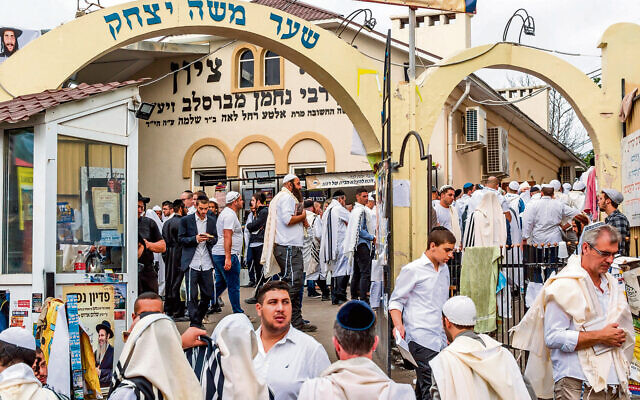A glance into Ukraine’s Chassidic history
Elements of the Ukrainian Jewish world that was largely destroyed during the Holocaust, still resonate across contemporary Jewry.
As the world focuses on Ukraine and Jewry pays particular attention to the situation of our fellow Jews now resident in the country, I thought to look at an element of Ukrainian Jewish history that still affects much of the Jewish world today.
For broadly speaking, Ukraine (albeit that its geographic extent has been and remains variously defined) was the cradle of the Chassidic movement that has touched so many of us even if we are not adherents of a particular Chassidic grouping.
Chassidism traces its origins to the famed Rabbi Israel Baal Shem Tov who was born in Okopy in West Ukraine, and died in Medzhybizh – at one time part of Poland but now in Ukraine. His tomb is a place of pilgrimage visited by Chassidim across the Chassidic spectrum.
Of his disciples, Dov Ber was chosen as his successor and then soon became the foremost personality of the early Chassidic world. He moved the focal centre of Chassidism to Mezeritch; hence he became known as the Mezeritcher Maggid.
Following the Baal Shem Tov’s passing in 1760, the Maggid would be at the helm of the nascent Chassidic world for some 12 years. During that time, despite opposition from some fearing change, Chassidism cemented its position as a movement intrinsic to a Jewish world struggling in the face of physical and spiritual problems. After his death a third generation of leadership, albeit with differing approaches within a philosophical framework, disseminated their perspective across appointed regions of eastern Europe, rapidly spreading a new approach to Jewish life beyond Ukraine, to Poland, Galicia, Hungary, Romania and Russia. The Maggid’s kever (burial place) is located in Hanipol, Ukraine.
Reb Levi Yitzchok of Berditchev, a city in northern Ukraine, was one of the Maggid’s key disciples. As “Saneiguron Shel Yisroel – the defender of Israel”, he is the subject of many Chassidic stories regarding the way he would intercede before God finding the positive element in the simplest or even wayward Jew.
Considered by some to be the founder of Chassidism in central Poland, he is buried in the old Jewish cemetery in Berditchev which is now part of Ukraine but was then under the control of the Russian Empire. As was the case of the kever of his teacher and mentor the Maggid, his kever too has become a site of pilgrimage cementing the connection of many in the contemporary Jewish world with Ukraine.
Undoubtedly one of the most famous Chassidic leaders associated with Ukraine is Nachman of Bratslav. Born in 1772, Rabbi Nachman’s maternal grandmother was the daughter of the Baal Shem Tov, while his father was the son of Reb Nachman of Horodenka, a disciple of the Baal Shem Tov. His burial place in Uman is now well known as the scene of substantial and somewhat controversial annual pilgrimages to Ukraine, particularly with the approach of the Yamim Noraim and his yahrzeit (Tishrei 18 on chol hamoed Succot).
Of course to so many Jews worldwide of varying levels of Jewish involvement and with lifestyles far from that of the Charedi Chassidic world, Chabad–Lubavitch is almost synonymous with Chassidism. In fact however, and despite the strength of Chabad in contemporary Ukraine where there are currently nearly 200 shluchim families across the length and breadth of the country, the origins of Chabad – and, for that matter, the town of Lubavitch per se – are not in Ukraine.
Its founder, Rabbi Shneur Zalman of Liadi known as the Alter Rebbe, never lived in Ukraine, having spent his life in today’s Belarus – in Liozna, and Vitebsk including Liadi where he settled after his release from incarceration. Nevertheless, in the context of the Napoleonic Wars between France and Russia, and with the French army advancing rapidly toward his hometown of Liadi, the Rebbe who had advocated for support for the Tsarist government against Napoleon determined to flee Liadi. While en route to the Ukrainian city of Kremenchuk, he fell ill in the small town of Piena near Poltava in Central Ukraine. In his final hours he made reference to close by Haditch. He was actually buried there, thereby transforming an anonymous shtetl into another point in the Ukrainian landscape integral to Chassidic history.
Of course there is so much more to be said regarding Ukraine and Chassidut. As an example, Chernobyl is known to many as the site of the 1986 disastrous nuclear accident involving a reactor in the Chernobyl nuclear power plant. However it is also the place of origin of a Chassidic dynasty founded by Reb Menachem Nachum Twersky, who initially served there as a maggid. The Chernobyl lineage has continued such that most people with the last name Twersky (or Twerski) are likely to be descendants of the Chernobyl dynasty.
Elsewhere, Chortkov in the Tarnopol governorate lent its name to another Chassidic dynasty (with which an earlier generation of my late mother’s family had a connection). And given the ever changing borders in that part of the world, one might even mention Munkacs. That town, formerly lying within the borders of Czechoslovakia, and before that Hungary (when its Chassidic dynasty with Hungarian leanings had its origins), is currently in Western Ukraine where it is also the subject of pilgrimages by adherents to its Chassidic approach.
May this Shabbat indeed be a Shabbat shalom, a Shabbat where peace reigns across the world.
Yossi
Yossi Aron OAM is The AJN’s religious affairs editor


comments